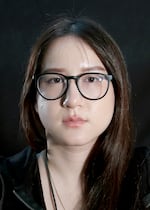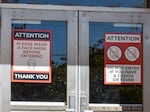OPB has been following 27 students since they were in first grade as part of the Class of 2025 project to track the state's progress toward 100% high school graduation starting in 2025.
When COVID-19 first shut down schools in March 2020, the Class of 2025 was in 7th grade: the middle of middle school. School buildings shuttered and education shifted online for all students, forever disrupting the learning experience for the cohort at the heart of Oregon’s long-term graduation goals.
Johnathan has always been a fast learner. When he was younger, he could talk on and on about the motorcycles or the cars he worked on with his dad.
Like many of the students in OPB’s Class of 2025, when COVID-19 hit Oregon, he was at Ron Russell Middle School in Southeast Portland.
“The first four or five months of COVID, I don’t remember anything,” he said.

FILE: A sign reminds visitors to mask up at Prescott Elementary school, in February 2022. Students and teachers are continuing to adjust to learning in a post-COVID environment, years after Oregon schools returned to in-person instruction.
Kristyna Wentz-Graff / OPB
Now, Johnathan has his driver’s license, balancing a busy work schedule at an auto parts shop with school. He’s an 11th grader at the David Douglas Online Academy, a program that didn’t exist before COVID.
After an interrupted 7th grade and a fully online 8th grade, getting back into the habits of school after distance learning proved difficult.
“I think that kind of led to a lot of procrastination among myself and definitely some other people around my age as well,” Johnathan said.
Now a junior, Johnathan has fallen behind on getting the credits he needs to graduate. On a recent winter afternoon, he wears a hoodie and a ball cap, armed with two energy drinks.
“‘How do I get back into this jam that I had before in middle school, before all of this stuff?’”
National and state reports may tell us how students perform on academic tests, or how many students experienced the loss of a parent due to COVID-19. But those raw data points only scratch the surface of how distance learning and other COVID-related changes interrupted their academic careers and undermined their paths to graduation and life afterwards.
Students and teachers are continuing to adjust to learning in a post-COVID environment, nearly three years since Oregon schools returned to in-person instruction.
For some students, their relationship with school has changed significantly.
State officials have changed their focus too. Leaders talk less about the goal for 100% of students in the Class of 2025 to reach graduation next year, instead zeroing in on literacy efforts for the state’s youngest learners.
Leyna, another student in the Class of 2025, said her life feels like a constant state of adjustment.
“To be a teenager right now is all about change because you have to adapt to like a lot of new technologies and a lot of new — just like a lot of new everything.”
Lost motivation, a “space missing”
Math has never been Leyna’s favorite subject. This year, she recalls struggling with square roots and trigonometry.
Though she feels more independence and freedom now compared to the COVID lockdowns, Leyna also senses a gap in her learning, starting when she first arrived in high school three years ago.
“I feel like the curriculums changed and then my brain kind of changed because I wasn’t able to keep up with what we were doing,” Leyna said. “It felt like there was a space missing.”
She now knows she learns better in person. She says it’s been challenging trying to form “genuine connections” with teachers and friends.
During the time at home in distance learning, Leyna found it difficult to stay motivated. She still struggles with that today. She said that lack of motivation sometimes contributes to attendance issues, a problem plaguing education officials statewide and nationally.

Leyna is a junior and one of the students in OPB's Class of 2025 project. She said being a teenager these days is "all about change".
Elizabeth Miller / OPB
She says if she could give her younger self a piece of advice, it would be to stay focused on school and keep putting in the effort.
“Don’t give up, even though it sounds corny — it’s easy to give up,” she said. “I did give up a lot of times throughout my life but I think the biggest part where I did give up and it affected me really on a large scale was probably last year.”
Tracy Apple, an English teacher at David Douglas, said it is tough to keep students engaged. She sees a lot more students tuning out than she did before the pandemic.
Before COVID, every week, Apple would assign students to take notes and turn them into a written analysis.
“Now I do one every three or four [weeks] because the kids get overwhelmed,” she said. “They can’t keep up and soon as they hit something that doesn’t make sense, they’re just like, ‘I can’t do it.’”
But sometimes that flexibility and extra support isn’t enough for struggling students — and they don’t pass a class.
If a student fails a class at David Douglas, the main option to make up for that lost credit is through a virtual credit recovery program students can access during the school day, after school, or in summer school. An analysis from the David Douglas School District shows that a higher percentage of students are making up more failed classes than they were before the pandemic.
Between decreased motivation, a reliance on technology, and the emotional toll of COVID, Apple worries how students might fare after graduation.
“A lot of schooling isn’t just education, it’s social and emotional development,” Apple said, noting that the pandemic also had a disproportionate impact on students in low-income households.
Some students are still recovering from COVID-related disruptions to school. The way students respond to these disruptions may show up differently — in behavior, in attendance habits, and on a report card. It’s hard to know how this time will affect students five or ten years down the line.
Alternative education environments
Less than two miles from David Douglas’ sprawling high school campus, a neon sign welcomes you to “Fir Ridge Campus,” a much smaller alternative to the main high school.
It’s lunchtime at Fir Ridge, and teacher Jessica Classen is sitting in her mostly empty English classroom. Students pop their heads in to ask if they can grab a snack from her drawer. A couple of students sit at a table finishing their assignments.
The flexible, supportive environment at Fir Ridge is by design, as a “dropout prevention program” for high school students who aren’t succeeding in a traditional school environment. The small school of about 200 students is built around individual attention, mainly helping upperclassmen get the credits they need to graduate.
Students often get referred to Fir Ridge from David Douglas, a school of more than 2000. Here, classes are smaller and students ask Classen for help with a simple, “Hey, Jess.”
“It’s a lot harder for kids to just go unnoticed,” Classen said.
This campus existed before COVID, with the same goals. But among her students, Classen says she initially noticed a greater reliance on technology, like phones, and a reluctance to engage in conversations — something she didn’t see when she was a teacher before COVID.

FILE: Social distancing reminders like this one from 2021, were a common sight during the pandemic. Teacher Jessica Classen says when students returned to the classroom, she initially noticed a greater reliance on technology, like phones, and a reluctance to engage in conversations.
Brandon Swanson / OPB
Classen has had conversations with her own teenage daughter, who doesn’t attend Fir Ridge but has still felt the lasting effects of COVID and its disruptions to school.
“She’s like ‘mom, I think it stunted me,’” Classen recalled her daughter. “She’s like, ‘I really feel like that time stunted me.’”
Classen’s classroom at Fir Ridge is set up to help students connect more — tables are organized in a “U” shape, with students facing each other and Classen’s own desk in the center. Handwritten agreements on the wall address how both teacher and students should treat each other and hold each other accountable.
While Fir Ridge has long been an option for David Douglas students, a new, different school structure popped up in the last four years: The David Douglas Online Academy.
Online learning and shifting priorities
Initial efforts at distance learning were widely panned by students and teachers alike. For Class of 2025 junior Johnathan, online learning was a difficult, sudden change. But that’s not his feeling toward learning online now, three years later. He’s different and the program is different.
When the David Douglas Online Academy first started in 2021, principal Shawna Myers said families chose the school for COVID-related reasons, staying at home to avoid crowds and potential exposure to the virus.
Myers says now students enroll in DDOA because it works for them.
“They’re choosing to be here and it’s great to see them wanting to be here and then excelling in here,” she said.
Students want to graduate early, or they’ve struggled in person due to anxiety, or they just work better on their own.
Students’ main reason to go to DDOA? Flexibility.
That’s part of what Johnathan loves about it, now that he’s trying to balance finishing high school with a part-time job.
“Let’s say I’m off one day, cool, I could start doing school work at 10 a.m.,” he explained. “If I’ve been working all day, cool, when I get home I’m going to start doing school work at 10 p.m.”

Johnathan, one of the students in the Class of 2025, is an 11th grader at the David Douglas Online Academy. He said the online program gives him flexibility to do schoolwork around his work schedule.
Elizabeth Miller / OPB
Johnathan says he would never have considered online school if COVID hadn’t happened. Because of the school’s flexibility, he’s able to work more hours at the auto parts store, where he’s picked up more responsibilities.
“I’m glad that I’ve been able to help out as much as I can,” he said.
But Johnathan’s priorities have shifted. He says he enjoys work more than school and that it has taken priority over school.
“I’m getting too, almost too focused on work, which is why I’m getting kind of less and less in school,” he said. “I think I need to go back, present more of myself in school, because I know I only have a year and a half left of it at this point.”
Johnathan said he fell off track during his first two years of high school. Earlier this school year, Johnathan talked about those failed courses as holes in his “boat down the river of graduation”.
“It’s like half filling up with water almost, I just want to make it through before I sink,” he said then.
Now, in March, Johnathan says there’s still water coming through the “cracks of the floorboard,” but now he’s focused on building a whole different vessel: his career.
”I’ve started to kind of build a bigger ship rather than focus on those little cracks and I think I kind of need to stop building, go back to those cracks and start filling them.”
He learns things at work that he can’t learn at school, such as how to interact with people of different ages and from all walks of life.
Myers, the DDOA principal, says she sees a lot of students who need to catch up. Students who were in distance learning during middle school often have to develop study or resilience skills they didn’t build during the pandemic.
“It’s a whole strategy too, not just the content but learning how to pace yourself and how to make sure that you finish,” she said.
Maintaining high expectations and pressure
The range of student experiences is broad, and the pandemic’s impact on school careers played a larger role in some students’ lives than others.
There are always going to be students who take advanced courses for college credit in high school, or who graduate early.
Statewide, data from the Oregon Department of Education show that the percentage of high school students taking advanced placement and other courses declined after the pandemic, but has rebounded a bit. In the 2022-2023 school year, 21.9% of Oregon high school students enrolled in at least one of those advanced courses, compared to 20.7% in 2021-2022.
A David Douglas High School district analysis of data tells a similar story. But this school year, participation in advanced courses trends downward.
Class of 2025 student Anna is in advanced classes, and has been for years. But she said she struggled with motivation back in middle school, before anyone had heard of COVID-19. She would procrastinate and put off homework or other assignments.
So in 7th grade, she wrote herself a letter.
“I said in the future, you need to focus on yourself a lot more, you need to actually do stuff on time instead of pushing yourself to do it last minute.”
Her 7th grade letter is in line with the expectations she’s set to go to college after high school. The pandemic and distance learning didn’t really change that. In fact, she was “enraged” when schools statewide shifted their grading policy to pass/no pass when schools first closed.

Class of 2025 student Anna, now a junior, wrote herself a letter back in 7th grade, telling her to focus on herself more and procrastinate less. The pandemic and distance learning didn't really change the plans she's made for herself.
Elizabeth Miller / OPB
But despite her own achievements, she still thinks about the skills she never learned.
“I felt that year was really important about learning grammar rules and learning about different types of clauses and sentence structure and whatnot,” she said.
As the range of student needs and capabilities appear to have grown since the pandemic, what students learn — and how they learn — varies greatly.
During distance learning in 8th grade, Johnathan said he struggled with “mind-bogglingly repetitive” instruction.
“The teachers were really doing the best that they could with what they had, but it was so difficult for most of us … to kind of get that focus and have the motivation to like ‘oh, let’s get on the computer and just kind of sit around for the next six hours,” he said.
Anna, on the other hand, missed the opportunity for more repetition and practice, something that was harder to get online.
“When it comes to really important topics, in order for you to grasp them, it has to be ingrained in your brain, you have to keep being taught the same things over and over again and that’s how it sticks in your brain,” Anna said.
When she studies for a test, she physically writes out all her notes and makes online flashcards.
“I tend to study a bit too much,” Anna said.
Sometimes students know exactly what they missed out on during distance learning. For Anna, it was an 8th-grade lesson on rocket science that couldn’t really work online.
Now as a junior, Anna says she still thinks about what she told herself in seventh grade. She says she procrastinates less than she used to, in part because if she falls behind, her heavy homework load makes it almost impossible to catch back up.
Shawna Myers, the David Douglas Online Academy principal, said she hopes students have come out of the last four years knowing that “they can get through anything” and that help is always available.
“I think it’s gonna be a long time before we actually get through it,” Myers said.
“It’s not that we’re just back in school and we’re fine. I think we’ve got years to come of putting pieces back together and healing everyone.”

FILE: Signs at Richmond Elementary in southeast Portland require masks to enter the school. Portland Public Schools started the school year online because of COVID-19.
Elizabeth Miller / OPB
